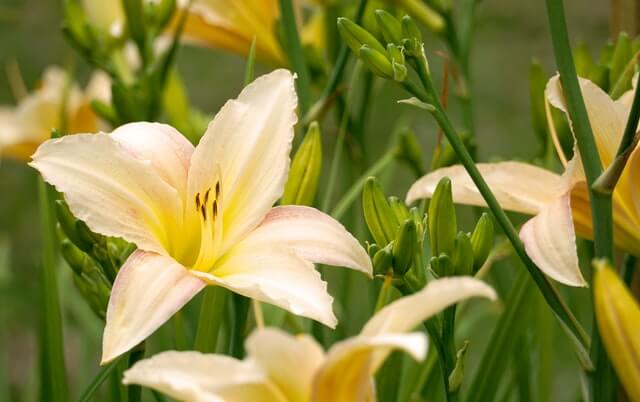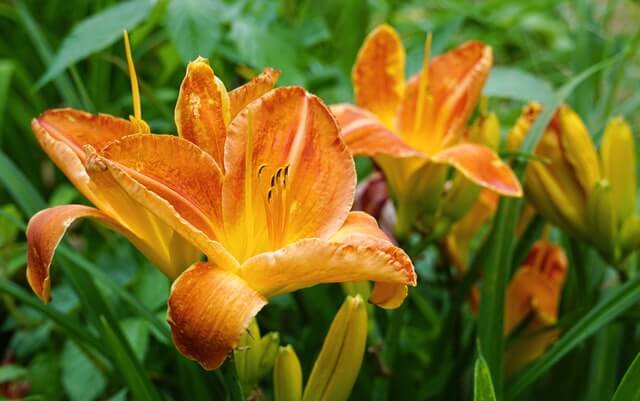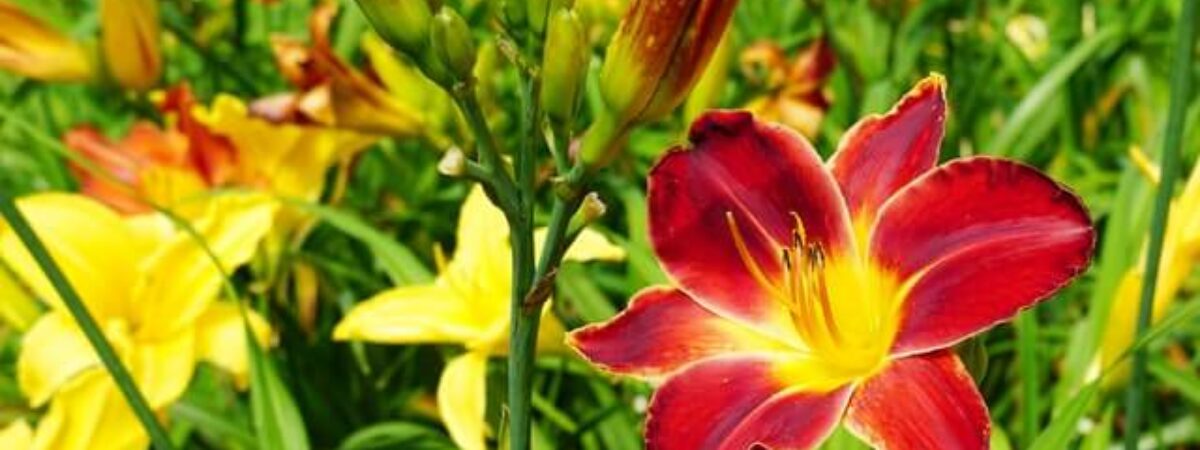When it comes to planting a plant that looks stunning and that is actually tough as nails, no doubt Daylilies come to mind at first sight.
Daylilies are the most popular, easiest growing, happy blooming perennial plants that grow well in a sunny garden.
Being a low-maintenance plant, these happy bloomers require minimal care to grow and produce abundant blooms in a spectacular array of forms and colors.
Do you want to grow this beautiful plant in your garden? Are you ready to have a day lily of your own? Our helpful growing and caring guide of Daylilies is here to light up your way.
Plant overview
Daylilies are the beautiful perennial plants scientifically named the Hemerocallis. It is a low-maintenance plant that is very easy to take care of. The flowers of the Daylilies bloom in the day, wither in the night, and again new flowers bloom the next morning.
With three sepals and three leaf-like petals that protect the flower buds, these blossoms grow up to 15 inches long with an extensive range of color and smell.
Daylilies generally grow from the roots and flowers grow in the flower stalk without leaves that are on the scales as opposed to the stems. Any mature plant can have up to six scales in it and each scape of the flowers grows up to 12 to 15 buds in it. Sometimes these scales can grow up to six feet tall.
Daylilies are the most popular, easiest growing, happy blooming perennial plants that grow well in a sunny garden. Click To TweetAre Daylilies poisonous?
Daylilies are not poisonous to humans and dogs, but they are toxic to cats. However, if they are ingested by the dogs, it can make their stomach upset. However, they look similar to the water lilies that are poisonous to both cats and dogs.

Varieties of Daylilies to grow in your garden
There are thousands of varieties of Daylilies. Some of those flowers rebloom throughout the seasons whereas some of those Daylilies remain green throughout the winter season. So let’s have a look at some popular varieties of Daylilies.
Stella de Oro
This variety of Daylilies enriches the beauty of the plant with beautiful yellow flower buds on each scape. It reblooms throughout the season.
Little Grapette
As the name suggests, this variety of Daylilies blooms purple color beautiful flowers. The plant grows up to 12 inches tall with early summer bloom time.
Ruby Spider
This variety of the Daylilies has beautiful scarlet flowers with golden throats. This variety grows up to nine inches in height.
Catherine Woodberry
This variety of Daylilies blooms pastel pink flowers that have great fragrance. This variety of plants blooms in mid to late summer.
Siloam Double Classic
This variety got its name as the flowers typically blossom twice, between early to mid-summer. This variety of flowers is salmon-colored and has a great fragrance.
Where and when to plant Daylilies?
It doesn’t matter where you plant Daylilies due to their hardiness. They bloom everywhere they plant. However, the proper time of planting matters a lot. It is recommended to plant the Daylilies in early spring when the soil is warmed enough to work.
You can also plant them in early fall, generally six weeks before the first frost.
How to plant Daylilies?
While planting Daylilies in the ground or a container, Dig a hole deep enough so that the crown of the plant can be at the same depth as originally grown. A band of white at the base of the foliage is the indication of the part that was underground.
Add some fertilizer to the soil to facilitate the growth of the plant. High phosphorus fertilizer is often recommended.
Water the newly planted Daylilies plant regularly and you also can add mulch to hold the moisture in the soil.
Daylilies are rarely grown from the seeds by the gardener as they rarely show the characteristics of the parent plant.

Caring guide of Daylilies
Sunlight
Daylilies thrive well in full sun. So make sure that your plant gets at least six to seven hours of sunlight every day. Although Daylilies can do well in shady conditions, planting them in full sun ensures the blooms and can help you to get the most out of them.
Besides, some extra afternoons are necessary for the plant to keep the plant in good health during extra hot climates.
Water
Daylilies do well when they get constant watering of 1inch per day. Watering the Daylilies plant is often necessary during the formation of scales and buds and also during the bloom. Besides, some varieties of Daylilies can also tolerate drought.
Watering of plants is often recommended every few days until the roots are established. Once the roots get established, water it regularly once a week when the soil becomes dry. You can also add mulch to the flower bed that will help to keep the soil moist.
Soil
Daylilies can grow well in every type of soil. However, they prefer fertile and loamy soil to grow well. The soil should be moist. So if you are growing your plant in clayey or loamy soil, it is recommended to add some compost to retain moisture.
Daylilies prefer well-drained, moist, medium to rich soil. They also can grow in poor soil. However, they can’t tolerate soil with a poor drainage system.
Temperature
Daylilies are tough plants that can withstand most temperatures.
Fertilizer
Being a low-maintenance plant, Daylilies don’t require fertilizer too much. However, they get benefits from a balanced fertilizer and appreciate some extra amount of nitrogen in it.
So it is recommended to fertilize the plant once or twice in the growing season and once in the fall to facilitate the growth, larger the bloom size, and prevent winter hardiness.

How to prune the Daylilies?
Pruning of the Daylilies plant is required regularly to keep them looking best, for subsequent blooming on flowering days.
To prune the plant, remove the yellow, and dead foliage from the plant by grasping firmly and giving a quick tug. Shear the plant to the level of new growth or to the 6 to 8 inches of the root to stem after the full blooming of the plant.
In mild climates, the plants can remain semi-green, and the plants can be cut back before the arrival of flowers, especially during the early spring.
Pruning of the Daylilies plant is required regularly to keep them looking best, for subsequent blooming on flowering days. Click To TweetCommon pests and diseases
Daylilies are not very prone to different pests and diseases. However, sometimes they are attacked by thrips, spider mites, and aphids. Snails and slugs can also attack the tender foliage of the plant. It can be cured by spreading insecticides in the plant.
Sometimes the Daylilies can be shown as a symbol of rusting when attacked by fungus. This also can be cured by taking the consultation of a local nursery about the rust-resistant type of plant in your location when planting the plant.
Conclusion
As you read the article this far, you might have got the idea of how to grow and care for Daylilies.
Daylilies are beautiful flowering plants with a lot of flower buds on each scape. Daylilies can add beauty to your indoor or outdoor garden and can make a great addition to the floral arrangements.
So what are you waiting for?
Read the growing and caring guidance of the plant and bring this beautiful flower to your home.
You may also like to read
How to grow and care for Pineapple Lily plant – A step-by-step guide
How to Grow and Care for Peace Lily Indoors- A Complete Guide






